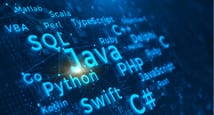- What is Cloud Computing
- How AWS is the leader in the cloud domain
- Various cloud computing products offered by AWS
- Introduction to AWS S3, EC2, VPC, EBS, ELB, AMI
- Getting a detailed understanding of the AWS architecture and the AWS Management Console
- Introduction to AWS EC2
- Comparing Public IP and Elastic IP
- Demonstrating how to launch an AWS EC2 instance
- What is auto scaling
- AWS EC2 best practices and cost involved
- Understanding various concepts of backup services in AWS
AWS DevOps Training in India
How to create a continuous integration and delivery capability without maintaining servers is highlighted in AWS DevOps ...Read more
Online
70 Hours
₹ 32034 39900
Quick Facts
| particular | details | ||||
|---|---|---|---|---|---|
|
Medium of instructions
English
|
Mode of learning
Self study, Virtual Classroom
|
Mode of Delivery
Video and Text Based
|
Frequency of Classes
Weekends
|
Course overview
The AWS DevOps Training in India will help in utilising online coding tools provided by AWS that can be used by students to browse, modify, and collaborate on projects.
Students who take AWS DevOps Training in India Classes assist the instructors in hastening the learning process for DevOps and demonstrating how AWS services may help eliminate the undifferentiated heavy lifting involved in DevOps adaptation.
AWS DevOps Training in India Certification Syllabus emphasises on DevOps and the services and features of the AWS platform that will improve a company's capacity for rapid delivery of apps and services.
All students get a AWS DevOps Training in India Certification by Intellipat and is supported by FutureSkills (NASSCOM Certification).
The highlights
- Provided by Intellipat
- Online course
- Learn at your own pace
- Mentor Support
- Shareable Certificate
- Expert Lectures
Program offerings
- Video lectures
- Study materials.
Course and certificate fees
Fees information
The AWS DevOps Training in India Certification Fees is mentioned below:
Description | Amount |
Course Fees | ₹39,900 |
| Discounted Fees | ₹32,034 |
certificate availability
Yes
certificate providing authority
Intellipaat
Who it is for
Below are the prospective career options that one can look out for after they have completed AWS DevOps Training in India:
- DevOps Architect
- DevOps Engineer
Eligibility criteria
Certificate Qualifying Details
Certification will only be awarded when the course is completed successfully after expert review, and quiz and also scoring around 60% in the end quiz.
Work experience
It does not matter wether you are a fresher or have any working experience, you shall nevertheless be eligible for this certification course.
What you will learn
AWS DevOps Training in India Certification Course incorporates the most recent cloud technologies to help you become an AWS DevOps certified professional and gives excellent value to your career by keeping in mind the unique industry criteria.
The following learning outcomes are achieved upon successful conclusion of this AWS DevOps Training in India:
- Utilise DevOps best practises to quickly create, deliver, and maintain apps and services on AWS.
- Describe the benefits, functions, and duties of small, independent DevOps teams.
- Create and put into place a DevOps development project-supporting infrastructure using Amazon Web Services.
The syllabus
Module 1: Introduction to Cloud Computing & AWS
Module 2: Database services
- Elastic Block Storage (EBS) for block level persistent storage volumes with S3 buckets
- Understanding Amazon RDS and Amazon Aurora which are relational databases
- Amazon DynamoDB which is a NoSQL database
- Understanding Amazon Redshift which is a data warehousing product
- Amazon ElasticCache which is an in-memory data store
- Deploying AWS database migration service
Module 3: Object Storage
- Introduction to AWS storage
- AWS S3 (Simple Storage Service)
- Creating an AWS S3 bucket
- AWS Storage Gateway
- Understanding the Command Line Interface (CLI)
- Hosting a static website using Amazon S3
- Amazon Glacier storage for long-term data backup and archiving
- Amazon Snowball for data import/export
Module 4: Autoscaling and load balancing
- Understanding Fault Tolerance in AWS
- In-depth study of Elastic Load Balancing
- The types of Load Balancers viz. Classic and Application
- AWS Auto Scaling mechanism
- Understanding AWS Management Console
- How to access the Elastic Load Balancing
- Studying AWS SDK, AWS CLI and Https Query API
Module 5: Virtual Private Cloud
- What is Amazon VPC
- VPC as a networking layer for EC2
- Getting started with VPC
- Examples
- VPC and Subnets
- Default and non-default VPCs
- Components of VPC networking
- IP addressing
- Security
- VPN connections
- Accessing the internet
- Using AWS PrivateLink to access the services
- VPC supported platforms
Module 6: Application services, AWS Lambda and CLI
- Introduction to various AWS application services
- Elastic Beanstalk
- Simple Email Services (SES)
- Simple Notification Service (SNS)
- AWS Lambda
- Elastic OpsWorks and CLI
Module 7: IAM and monitoring
- Authentication (who can use) and Authorization (level of access)
- IAM Policies – JSON structure, users, groups and their Roles
- IAM HTTPS API
- Logging IAM events with AWS CloudTrail
- Monitoring and managing AWS resources using CloudWatch
- Deploying configuration alerts and notifications with CloudWatch
- Billing for CloudWatch
Module 8: Configuration management and automation
- Configuration management and automation of server configuration using OpsWorks
- Determining how servers are configured, managed and deployed across EC2 instances
- Creating a virtual machine using Amazon Machine Image (AMI)
- Introduction to the Domain Name Registration service AWS Route 53
- How to route internet traffic to resources
- Checking health of resources automatically
- Provisioning of infrastructure resources using AWS CloudFormation
Module 9: Architecting AWS – whitepaper
- Important guidelines for creating a well architected AWS framework that is resilient and performant
- Designing fault-tolerant and high-availability architecture, resilient storage, decoupling mechanism, multi-tier architecture solution, disaster recovery solution, scalable and elastic solutions
Module 10: AWS Architect Questions
- Guidance for clearing the exam
- Most probable interview questions and other helpful tips for clearing the exam and interview
Module 11: AWS Migration
- Migrating to the AWS cloud
- Business drivers for migration
- Various stages of cloud adoption
- The actual migration process
- Migration tools and services in AWS
- Migrating customers to AWS cloud
- Track the progress of application migration
- Types of migration including data migration, application migration and databases migration
Module 12: AWS Security
- AWS cloud security essentials
- Penetration testing
- Security compliance
- Infrastructure security
- Mitigating DDOS
- Identity and Access Control (IAM)
- Logging and monitoring
- Automatic audits and compliance
- Limitations and challenges of native AWS security
Module 13: Infrastructure Setup
Installation of Devops Tools on AWS
- Git
- Docker
- Selenium
- Maven
- Jenkins
- Puppet
- Ansible
- Kubernetes
- Nagios
Module 14: Introduction to Devops
- What is Software Development
- Software Development Life Cycle
- Traditional Models for SDLC
- Why Devops?
- What is Devops?
- Devops Lifecycle
- Devops Tools
Module 15: Software Version Control
- What is Version Control
- Types of Version Control System
- Introduction to SVN
- Introduction to Git
- Git Lifecycle
- Common Git Commands
- Working with Branches in Git
- Merging Branches
- Resolving Merge Conflicts
- Git Workflow
Module 16: Containerization using Docker - Part I
- Introduction to Docker
- Understanding Docker Lifecycle
- Components of Docker Ecosystem
- Common Docker Operations
- Creating a DockerHub Account
- Committing changes in a Container
- Pushing a Container Image to DockerHub
- Creating Custom Docker Images using Dockerfile
Module 17: Containerization using Docker - Part II
- What are Docker Volumes
- Deploying a Multi-Tier Application using Docker Network
- Using Docker Compose to deploy containers
- What is Container Orchestration
- Container Orchestration Tools
- Introduction to Docker Swarm
- Deploying a 2-Node Cluster using Docker Swarm
Module 18: Configuration Management using Puppet
- Need of Configuration Management
- Configuration Management Tools
- What is Puppet
- Puppet Architecture
- Setting up Master Slave using Puppet
- Puppet Manifests
- Puppet Modules
- Applying configuration using Puppet
- Puppet File Server
Module 19: Configuration Management using Ansible
- What is Ansible?
- Ansible vs Puppet
- Ansible Architecture
- Setting up Master Slave using Ansible
- Ansible Playbook
- Ansible Roles
- Applying configuration using Ansible
Module 20: Continuous Testing
- What is Continuous Testing?
- What is Maven?
- Running Test Cases on Chromium Web Driver
- What is Headless Mode?
Module 21: Continuous Integration using Jenkins
- Introduction to Continuous Integration
- Jenkins Master Slave Architecture
- Understanding CI/CD Pipelines
- Creating an end to end automated CI/CD Pipeline
Module 22: Continuous Orchestration using Kubernetes
- Introduction to Kubernetes
- Docker Swarm vs Kubernetes
- Kubernetes Architecture
- Deploying Kubernetes using Kubeadms
- Alternate ways of deploying Kubernetes
- YAML Files
- Creating a Deployment in Kubernetes using YAML
- Services in Kubernetes
- Ingress in Kubernetes
Module 23: Continuous Monitoring using Nagios
- What is Continuous Monitoring
- Introduction to Nagios
- Nagios Architecture
- Monitoring Services in Nagios
- What are NRPE Plugins
- Monitoring System Info using NRPE plugins
Module 24: DevOps on AWS
- How to deploy DevOps principles and methodology on the AWS platform
- DevOps lifecycle and the important stages in the DevOps methodology
- What is AWS CodeBuild
- AWS CodeCommit
- AWS CodePipeline
- AWS CodeDeploy
Module 25: Deploying Infrastructure with Terraform
- Installing Terraform – Windows Users
- Installing Terraform – Linux Users
- Choosing Right IDE for Terraform IAC development
- Creating first EC2 instance with Terraform
- Terraform Code – First EC2 Instance
- Understanding Resources & Providers
- Destroying Infrastructure with Terraform
- Destroying Specific Resource
- Understanding Terraform State files
- Understanding Desired & Current States
- Challenges with the current state on computed values
- Terraform Commands – State Files
- Terraform Provider Versioning
- Types of Terraform Providers
- Understanding Attributes and Output Values in Terraform
- Attribute Resource (Document)
- Referencing Cross-Account Resource Attributes
- Terraform Variables
- Data Types for Variables
- Fetching Data from Maps and List in Variable
- Terraform Format
- Validating Terraform Configuration Files
Module 26: Terraform Modules and Workspaces
- What is Infrastructure as a code
- Iac vs Configuration Management
- Introduction to Terraform
- Installing Terraform on AWS
- Basic Operations in terraform
- init
- plan
- apply
- destroy
- Terraform Code Basics
- Deploying and end-to-end architecture on AWS using Terraform
Admission details
All the steps mentioned below must be followed by all of the interested students related to the AWS DevOps Training in India classes:
Step 1: Go and see the official website
Step 2: Write the application form through the website.
Step 3: Upload all necessary supporting documents, and theresfater pay the fee using the online mode.
Step 4: Then get started with the course learning.
Evaluation process
Yes, there will be quizzes and projects.
How it helps
AWS DevOps Training in India Certification Benefits includes the ability to bring agility to your business and IT organisation and accelerate your journey to the cloud. Technology companies should embrace DevOps principles and practices. After completing the training, will make the journey to the cloud smooth, efficient, and effective - you can further have a look into Devops Certification Courses.
FAQs
What is AWS in DevOps?
Amazon Web Services offers services that are created specifically for use with AWS and that assist you in implementing DevOps at your business.
How are the classes for the AWS DevOps Training in India Online Course being held?
The classes are delivered through pre-recorded videos and lectures.
What is the role of the AWS DevOps engineer?
You will be in charge of putting application solutions on the cloud and conducting technological research as a DevOps engineer.
Is DevOps with AWS easy to learn?
No, it requires an understanding of basic DevOps concepts and AWS tools, along with programming languages.
Is there any job assistance?
Yes, Intellipaat actively helps all students who successfully complete the course find employment.


 Brochure
Brochure Enquire
Enquire










